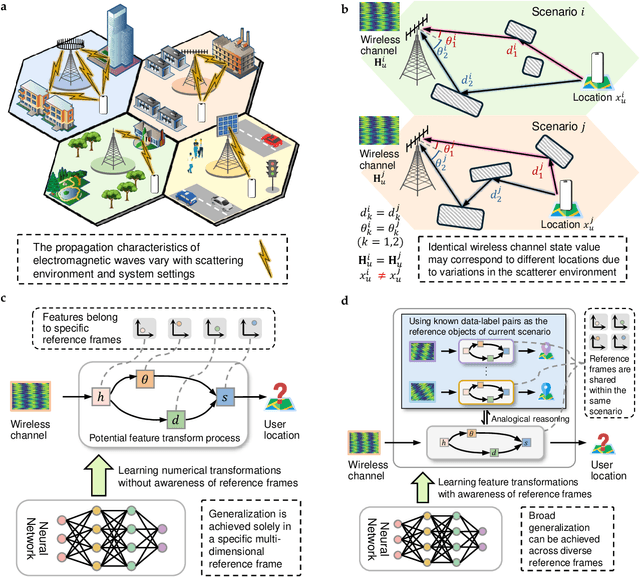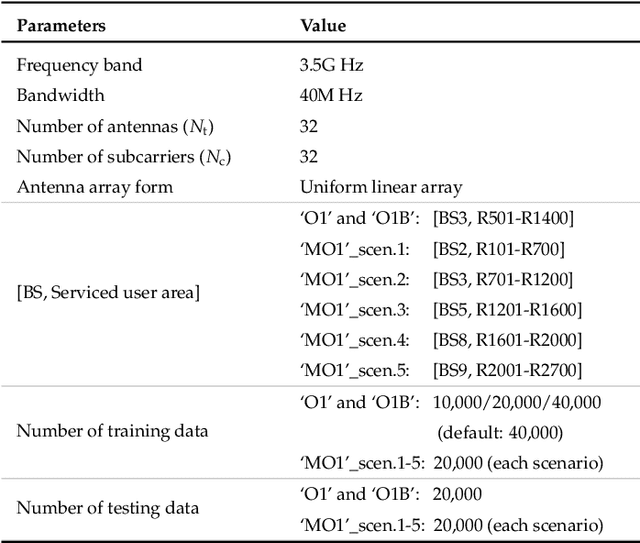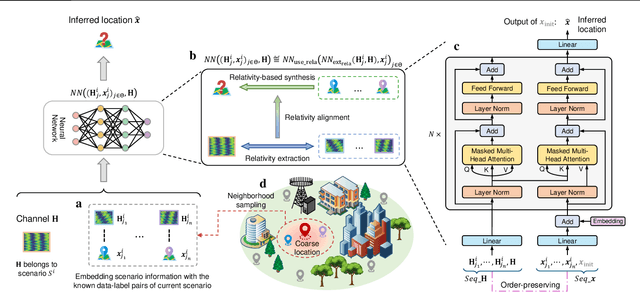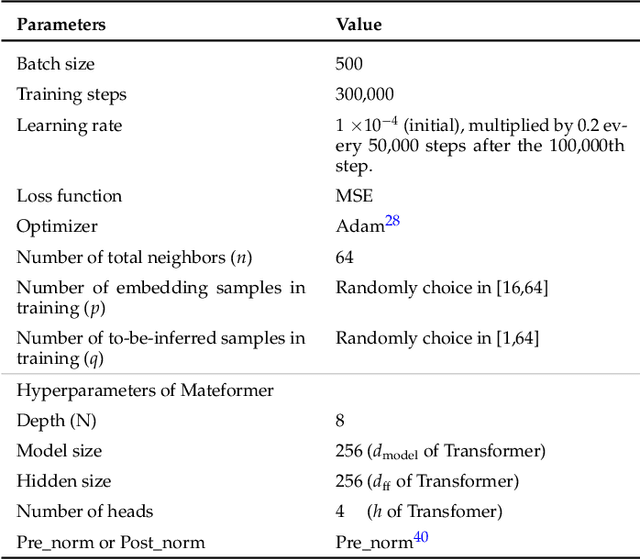Chongwen Huang
Dynamical Multimodal Fusion with Mixture-of-Experts for Localizations
Jul 02, 2025Abstract:Multimodal fingerprinting is a crucial technique to sub-meter 6G integrated sensing and communications (ISAC) localization, but two hurdles block deployment: (i) the contribution each modality makes to the target position varies with the operating conditions such as carrier frequency, and (ii) spatial and fingerprint ambiguities markedly undermine localization accuracy, especially in non-line-of-sight (NLOS) scenarios. To solve these problems, we introduce SCADF-MoE, a spatial-context aware dynamic fusion network built on a soft mixture-of-experts backbone. SCADF-MoE first clusters neighboring points into short trajectories to inject explicit spatial context. Then, it adaptively fuses channel state information, angle of arrival profile, distance, and gain through its learnable MoE router, so that the most reliable cues dominate at each carrier band. The fused representation is fed to a modality-task MoE that simultaneously regresses the coordinates of every vertex in the trajectory and its centroid, thereby exploiting inter-point correlations. Finally, an auxiliary maximum-mean-discrepancy loss enforces expert diversity and mitigates gradient interference, stabilizing multi-task training. On three real urban layouts and three carrier bands (2.6, 6, 28 GHz), the model delivers consistent sub-meter MSE and halves unseen-NLOS error versus the best prior work. To our knowledge, this is the first work that leverages large-scale multimodal MoE for frequency-robust ISAC localization.
Over-the-Air ODE-Inspired Neural Network for Dual Task-Oriented Semantic Communications
May 08, 2025Abstract:Analog machine-learning hardware platforms promise greater speed and energy efficiency than their digital counterparts. Specifically, over-the-air analog computation allows offloading computation to the wireless propagation through carefully constructed transmitted signals. In addition, reconfigurable intelligent surface (RIS) is emerging as a promising solution for next-generation wireless networks, offering the ability to tailor the communication environment. Leveraging the advantages of RIS, we design and implement the ordinary differential equation (ODE) neural network using over-the-air computation (AirComp) and demonstrate its effectiveness for dual tasks. We engineer the ambient wireless propagation environment through distributed RISs to create an architecture termed the over-the-air ordinary differential equation (Air-ODE) network. Unlike the conventional digital ODE-inspired neural network, the Air-ODE block utilizes the physics of wave reflection and the reconfigurable phase shifts of RISs to implement an ODE block in the analog domain, enhancing spectrum efficiency. Moreover, the advantages of Air-ODE are demonstrated in a deep learning-based semantic communication (DeepSC) system by extracting effective semantic information to reduce the data transmission load, while achieving the dual functions of image reconstruction and semantic tagging simultaneously at the receiver. Simulation results show that the analog Air-ODE network can achieve similar performance to the digital ODE-inspired network. Specifically, for the image reconstruction and semantic tagging task, compared with the analog network without the Air-ODE block, the Air-ODE block can achieve around 2 times gain in both reconstruction quality and tagging accuracy.
Robust Deep Learning-Based Physical Layer Communications: Strategies and Approaches
May 02, 2025Abstract:Deep learning (DL) has emerged as a transformative technology with immense potential to reshape the sixth-generation (6G) wireless communication network. By utilizing advanced algorithms for feature extraction and pattern recognition, DL provides unprecedented capabilities in optimizing the network efficiency and performance, particularly in physical layer communications. Although DL technologies present the great potential, they also face significant challenges related to the robustness, which are expected to intensify in the complex and demanding 6G environment. Specifically, current DL models typically exhibit substantial performance degradation in dynamic environments with time-varying channels, interference of noise and different scenarios, which affect their effectiveness in diverse real-world applications. This paper provides a comprehensive overview of strategies and approaches for robust DL-based methods in physical layer communications. First we introduce the key challenges that current DL models face. Then we delve into a detailed examination of DL approaches specifically tailored to enhance robustness in 6G, which are classified into data-driven and model-driven strategies. Finally, we verify the effectiveness of these methods by case studies and outline future research directions.
Wireless Large AI Model: Shaping the AI-Native Future of 6G and Beyond
Apr 20, 2025Abstract:The emergence of sixth-generation and beyond communication systems is expected to fundamentally transform digital experiences through introducing unparalleled levels of intelligence, efficiency, and connectivity. A promising technology poised to enable this revolutionary vision is the wireless large AI model (WLAM), characterized by its exceptional capabilities in data processing, inference, and decision-making. In light of these remarkable capabilities, this paper provides a comprehensive survey of WLAM, elucidating its fundamental principles, diverse applications, critical challenges, and future research opportunities. We begin by introducing the background of WLAM and analyzing the key synergies with wireless networks, emphasizing the mutual benefits. Subsequently, we explore the foundational characteristics of WLAM, delving into their unique relevance in wireless environments. Then, the role of WLAM in optimizing wireless communication systems across various use cases and the reciprocal benefits are systematically investigated. Furthermore, we discuss the integration of WLAM with emerging technologies, highlighting their potential to enable transformative capabilities and breakthroughs in wireless communication. Finally, we thoroughly examine the high-level challenges hindering the practical implementation of WLAM and discuss pivotal future research directions.
Beamforming Design and Association Scheme for Multi-RIS Multi-User mmWave Systems Through Graph Neural Networks
Apr 20, 2025Abstract:Reconfigurable intelligent surface (RIS) is emerging as a promising technology for next-generation wireless communication networks, offering a variety of merits such as the ability to tailor the communication environment. Moreover, deploying multiple RISs helps mitigate severe signal blocking between the base station (BS) and users, providing a practical and efficient solution to enhance the service coverage. However, fully reaping the potential of a multi-RIS aided communication system requires solving a non-convex optimization problem. This challenge motivates the adoption of learning-based methods for determining the optimal policy. In this paper, we introduce a novel heterogeneous graph neural network (GNN) to effectively leverage the graph topology of a wireless communication environment. Specifically, we design an association scheme that selects a suitable RIS for each user. Then, we maximize the weighted sum rate (WSR) of all the users by iteratively optimizing the RIS association scheme, and beamforming designs until the considered heterogeneous GNN converges. Based on the proposed approach, each user is associated with the best RIS, which is shown to significantly improve the system capacity in multi-RIS multi-user millimeter wave (mmWave) communications. Specifically, simulation results demonstrate that the proposed heterogeneous GNN closely approaches the performance of the high-complexity alternating optimization (AO) algorithm in the considered multi-RIS aided communication system, and it outperforms other benchmark schemes. Moreover, the performance improvement achieved through the RIS association scheme is shown to be of the order of 30%.
Analogical Learning for Cross-Scenario Generalization: Framework and Application to Intelligent Localization
Apr 09, 2025



Abstract:Existing learning models often exhibit poor generalization when deployed across diverse scenarios. It is mainly due to that the underlying reference frame of the data varies with the deployment environment and settings. However, despite the data of each scenario has its distinct reference frame, its generation generally follows the same underlying physical rule. Based on these findings, this article proposes a brand-new universal deep learning framework named analogical learning (AL), which provides a highly efficient way to implicitly retrieve the reference frame information associated with a scenario and then to make accurate prediction by relative analogy across scenarios. Specifically, an elegant bipartite neural network architecture called Mateformer is designed, the first part of which calculates the relativity within multiple feature spaces between the input data and a small amount of embedded data from the current scenario, while the second part uses these relativity to guide the nonlinear analogy. We apply AL to the typical multi-scenario learning problem of intelligent wireless localization in cellular networks. Extensive experiments show that AL achieves state-of-the-art accuracy, stable transferability and robust adaptation to new scenarios without any tuning, and outperforming conventional methods with a precision improvement of nearly two orders of magnitude. All data and code are available at https://github.com/ziruichen-research/ALLoc.
Liquid Neural Networks: Next-Generation AI for Telecom from First Principles
Apr 03, 2025Abstract:Artificial intelligence (AI) has emerged as a transformative technology with immense potential to reshape the next-generation of wireless networks. By leveraging advanced algorithms and machine learning techniques, AI offers unprecedented capabilities in optimizing network performance, enhancing data processing efficiency, and enabling smarter decision-making processes. However, existing AI solutions face significant challenges in terms of robustness and interpretability. Specifically, current AI models exhibit substantial performance degradation in dynamic environments with varying data distributions, and the black-box nature of these algorithms raises concerns regarding safety, transparency, and fairness. This presents a major challenge in integrating AI into practical communication systems. Recently, a novel type of neural network, known as the liquid neural networks (LNNs), has been designed from first principles to address these issues. In this paper, we explore the potential of LNNs in telecommunications. First, we illustrate the mechanisms of LNNs and highlight their unique advantages over traditional networks. Then we unveil the opportunities that LNNs bring to future wireless networks. Furthermore, we discuss the challenges and design directions for the implementation of LNNs. Finally, we summarize the performance of LNNs in two case studies.
TeleMoM: Consensus-Driven Telecom Intelligence via Mixture of Models
Apr 03, 2025Abstract:Large language models (LLMs) face significant challenges in specialized domains like telecommunication (Telecom) due to technical complexity, specialized terminology, and rapidly evolving knowledge. Traditional methods, such as scaling model parameters or retraining on domain-specific corpora, are computationally expensive and yield diminishing returns, while existing approaches like retrieval-augmented generation, mixture of experts, and fine-tuning struggle with accuracy, efficiency, and coordination. To address this issue, we propose Telecom mixture of models (TeleMoM), a consensus-driven ensemble framework that integrates multiple LLMs for enhanced decision-making in Telecom. TeleMoM employs a two-stage process: proponent models generate justified responses, and an adjudicator finalizes decisions, supported by a quality-checking mechanism. This approach leverages strengths of diverse models to improve accuracy, reduce biases, and handle domain-specific complexities effectively. Evaluation results demonstrate that TeleMoM achieves a 9.7\% increase in answer accuracy, highlighting its effectiveness in Telecom applications.
Large-Scale AI in Telecom: Charting the Roadmap for Innovation, Scalability, and Enhanced Digital Experiences
Mar 06, 2025Abstract:This white paper discusses the role of large-scale AI in the telecommunications industry, with a specific focus on the potential of generative AI to revolutionize network functions and user experiences, especially in the context of 6G systems. It highlights the development and deployment of Large Telecom Models (LTMs), which are tailored AI models designed to address the complex challenges faced by modern telecom networks. The paper covers a wide range of topics, from the architecture and deployment strategies of LTMs to their applications in network management, resource allocation, and optimization. It also explores the regulatory, ethical, and standardization considerations for LTMs, offering insights into their future integration into telecom infrastructure. The goal is to provide a comprehensive roadmap for the adoption of LTMs to enhance scalability, performance, and user-centric innovation in telecom networks.
Electromagnetic Channel Modeling and Capacity Analysis for HMIMO Communications
Feb 06, 2025



Abstract:Advancements in emerging technologies, e.g., reconfigurable intelligent surfaces and holographic MIMO (HMIMO), facilitate unprecedented manipulation of electromagnetic (EM) waves, significantly enhancing the performance of wireless communication systems. To accurately characterize the achievable performance limits of these systems, it is crucial to develop a universal EM-compliant channel model. This paper addresses this necessity by proposing a comprehensive EM channel model tailored for realistic multi-path environments, accounting for the combined effects of antenna array configurations and propagation conditions in HMIMO communications. Both polarization phenomena and spatial correlation are incorporated into this probabilistic channel model. Additionally, physical constraints of antenna configurations, such as mutual coupling effects and energy consumption, are integrated into the channel modeling framework. Simulation results validate the effectiveness of the proposed probabilistic channel model, indicating that traditional Rician and Rayleigh fading models cannot accurately depict the channel characteristics and underestimate the channel capacity. More importantly, the proposed channel model outperforms free-space Green's functions in accurately depicting both near-field gain and multi-path effects in radiative near-field regions. These gains are much more evident in tri-polarized systems, highlighting the necessity of polarization interference elimination techniques. Moreover, the theoretical analysis accurately verifies that capacity decreases with expanding communication regions of two-user communications.
 Add to Chrome
Add to Chrome Add to Firefox
Add to Firefox Add to Edge
Add to Edge